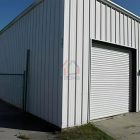Advantages of clear-span metal buildings in post-disaster reconstruction
Today, with frequent natural disasters, post-disaster reconstruction has become the focus of social attention. In this process, it is crucial to choose the right building form and materials. They are not only related to the speed and quality of reconstruction, but also directly affect the life safety and future development of the affected people. With its unique advantages, clear-span metal buildings have shown strong vitality and broad application prospects in post-disaster reconstruction.

1. Rapid reconstruction and shortened recovery period
The primary task of post-disaster reconstruction is to restore the basic living order in the disaster-stricken areas as soon as possible. With its prefabricated components and rapid assembly, clear-span metal buildings can complete a large number of construction tasks in a short time. Compared with traditional building materials, metal components have a high degree of standardization, a short production cycle, and are more convenient to transport and install. This efficient construction method greatly shortens the reconstruction cycle, reduces the time that the affected people spend in temporary resettlement sites, and helps them resume normal life faster.
2. Earthquake and wind resistance, improve safety performance
Natural disasters are often accompanied by strong earthquakes and storms. Clear-span metal buildings have excellent performance in earthquake and wind resistance with their excellent mechanical properties and structural stability. Metal materials have good elasticity and plasticity, and can effectively absorb and disperse the energy of seismic waves and wind, reducing the degree of damage to the building structure. At the same time, the design of clear span metal buildings often adopts advanced seismic resistance technology, such as seismic isolation bearings, shock absorbers, etc., which further improves the seismic resistance of the building. This high-security building form provides a reliable guarantee for post-disaster reconstruction.

3. Flexible and adaptable to complex environments
Post-disaster reconstruction often faces complex and changeable environmental conditions. With its flexible and changeable structural form and good adaptability, the clear span metal building can meet the construction needs under different terrain and climatic conditions. Whether it is mountainous, hilly or plain areas, the clear span metal building can be adjusted and optimized according to actual conditions to ensure the safety and stability of the building. In addition, the plasticity and processability of metal materials also make the building form more diversified, which can meet different functions and usage requirements.
4. Environmental protection and sustainability, in line with the concept of green development
In post-disaster reconstruction, environmental protection and sustainable development are important issues that cannot be ignored. The clear span metal building, with its environmental protection and sustainable characteristics, is in line with the current development trend of green buildings. Metal materials can be recycled and reused, reducing the generation of construction waste and the waste of resources. At the same time, metal buildings generate relatively less pollution during construction and use, which is conducive to protecting the ecological environment and reducing carbon emissions. This environmentally friendly and sustainable form of construction provides strong support for the sustainable development of post-disaster reconstruction.

Clear-span metal buildings have shown multiple advantages in post-disaster reconstruction, such as rapid reconstruction, earthquake resistance and wind resistance, flexibility and environmental sustainability. These advantages make net-span metal buildings one of the important choices in post-disaster reconstruction, and contribute positively to the recovery and development of disaster-stricken areas. In the future, with the continuous advancement of science and technology and the continuous renewal of architectural concepts, the application prospects of net-span metal buildings in post-disaster reconstruction will be broader.












